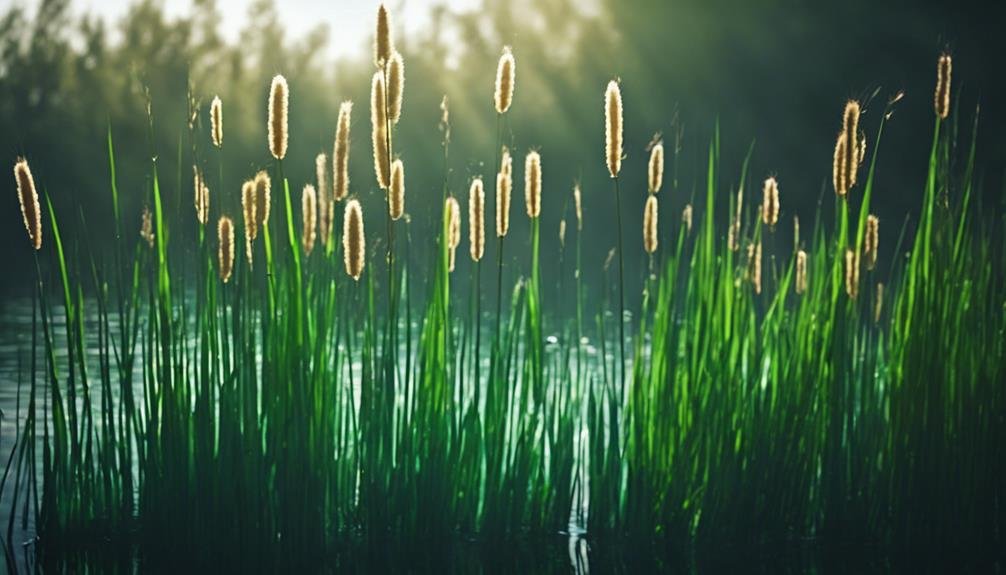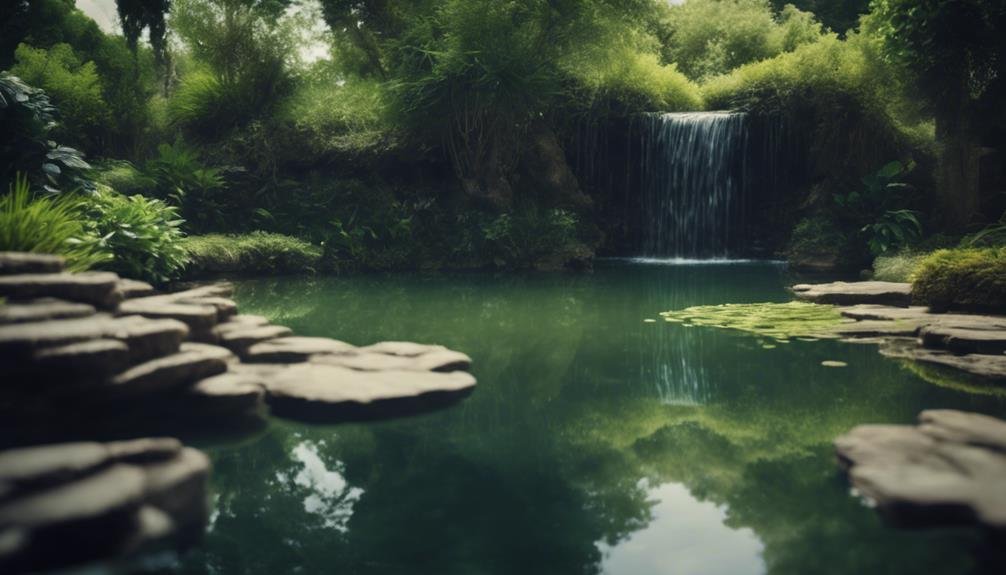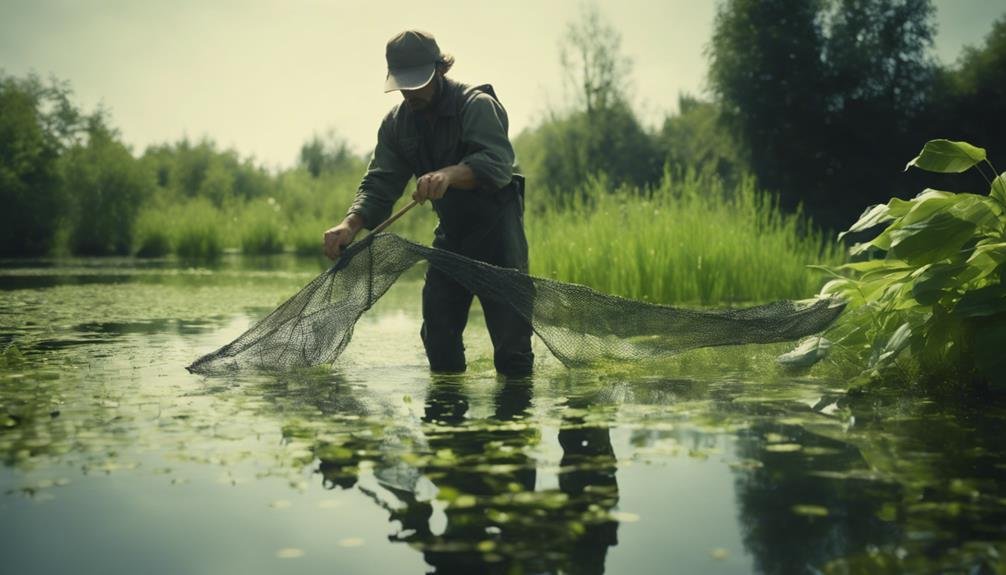Maintaining a healthy pond without the use of harmful chemicals is possible by leveraging natural processes. Aeration systems such as fountains and bubblers play a crucial role in ensuring proper oxygen levels in the water.
By introducing beneficial bacteria into the pond, you can effectively break down waste and improve water clarity. Aquatic plants like water lilies are great at absorbing excess nutrients, which helps in starving algae and preventing overgrowth.
In addition to these natural methods, incorporating filters like gravel beds and creating wetland areas can mimic the cleansing processes found in nature. Regularly removing debris from the pond is also essential to prevent stagnation and maintain a vibrant ecosystem.
Stocking algae-eating fish, such as grass carp, can further help in maintaining ecological balance and keeping algae growth in check.
By focusing on consistent circulation, controlling nutrient levels, and managing vegetation effectively, you can establish a comprehensive approach to keeping your pond healthy and chemical-free. This holistic approach not only benefits the pond's ecosystem but also contributes to a visually appealing and sustainable environment for plants and wildlife.
Mechanical Aeration Techniques
Looking to maintain pond cleanliness and oxygen levels naturally? Mechanical aeration techniques can be a great solution. One effective method is using fountains or aerators to agitate the water's surface, boosting oxygen levels. These devices can be powered by solar energy or electricity, making them eco-friendly options.
Another strategy is installing a bottom aeration system. By pumping air into the pond through diffusers placed at the bottom, bubbles are created to rise to the surface. This process enhances water circulation, preventing stagnation and ensuring a healthy oxygen balance throughout the pond.
Consider a windmill aerator as well, which utilizes wind power to rotate a shaft connected to an underwater propeller. As the propeller spins, it generates a current that circulates and oxygenates the water. This sustainable solution effectively maintains pond health by harnessing renewable energy sources.
Beneficial Bacteria Application
Adding beneficial bacteria to ponds can significantly improve water quality and clarity. These bacteria help break down organic matter and convert fish waste ammonia into less harmful compounds. By competing with algae for nutrients, they can reduce the occurrence of unsightly algal blooms.
To apply beneficial bacteria, it's recommended to purchase concentrated powders or liquids containing specific bacterial strains. Following the product instructions, evenly disperse the bacteria around the pond's perimeter. It's crucial to maintain proper oxygen levels, as beneficial bacteria thrive in oxygenated conditions.
Some products combine bacteria with enzymes to enhance organic sludge digestion, leading to rapid water clarity improvement by clearing accumulated debris. However, caution is advised to prevent oxygen depletion and harm to aquatic life from overuse. Regularly dosing ponds with beneficial microbes at recommended levels allows for proactive water quality management without resorting to harsh chemicals, aligning with eco-friendly practices.
One recommended product is 'Pondzyme,' a bacterial enzyme blend designed to break down organic matter and reduce sludge buildup, enhancing overall pond health.
Another option is 'Aquascape Beneficial Bacteria,' containing specific strains to promote a balanced ecosystem by reducing excess nutrients and maintaining water clarity. By incorporating these beneficial bacteria products, pond owners can sustain a healthy aquatic environment naturally and effectively.
Aquatic Plant Promotion

To maintain a healthy pond ecosystem, it's crucial to promote the growth of aquatic plants alongside beneficial bacteria applications. Aquatic plants play a vital role by oxygenating the water through photosynthesis, creating a better environment for fish and other aquatic creatures. Additionally, their roots act as natural filters, absorbing excess nutrients that could lead to algae overgrowth.
Moreover, aquatic plants provide shelter and breeding areas for beneficial insects and amphibians, enhancing the pond's biodiversity. Some recommended plant options include Water Lilies, known for their beautiful floating blooms, Cattails, tall reeds that thrive in shallow water, and Hornwort, a submerged plant that oxygenates the water thoroughly.
Natural Filtration Systems
To improve pond cleanliness, we can enhance aquatic plant promotion by constructing natural filtration systems. These systems utilize gravel and sand beds, wetland areas with aquatic plants like cattails and rushes, and biological filters containing beneficial bacteria.
Gravel and sand beds serve as mechanical filters, capturing debris and allowing water to filter through effectively.
Wetland areas with diverse plant life not only enhance the natural beauty of the pond but also provide biological filtration by absorbing nutrients and hosting microbes that break down pollutants.
Biological filters play a crucial role by housing colonies of beneficial bacteria that consume organic matter, thereby maintaining the water's cleanliness.
Once these systems are set up, they require minimal maintenance, mimicking natural processes without the need for harsh chemicals. This approach creates a harmonious, self-sustaining ecosystem, ensuring a healthy pond environment without compromising water quality or harming aquatic life.
Water Circulation Enhancement

Improving water circulation is crucial for maintaining a clean and healthy pond environment. One way to achieve this is by installing a submersible pump or fountain to keep the water moving, preventing stagnation and ensuring oxygen is evenly distributed.
Another effective method is to strategically place aerators or bubblers at various depths to increase oxygen levels and create gentle water movements that discourage algae growth and prevent debris buildup.
Integrating waterfalls or streams into the pond design not only enhances visual appeal but also helps oxygenate the water and prevent stratification. This natural flow promotes a balanced ecosystem and reduces the reliance on chemical treatments for pond maintenance.
It's essential to combine proper water circulation with other natural methods like beneficial bacteria and plant life to ensure optimal pond health. By implementing these techniques, ponds can stay clean and thriving without the need for harmful chemicals.
Nutrient Load Reduction
To reduce the nutrient load in our pond, we can take several steps. First, we should limit the amount of fertilizer runoff from the surrounding areas. Excess nutrients from fertilizers can lead to algal blooms, which can harm the ecosystem.
One way to combat this is by promoting the growth of aquatic plants in the pond. These plants naturally absorb nutrients from the water, helping to keep the balance in check.
In addition to promoting aquatic plants, we can also consider installing aeration and circulation systems in the pond. These systems help prevent stagnant areas where nutrients tend to accumulate, promoting better water quality overall.
By keeping the water moving and well-oxygenated, we can create a healthier environment for aquatic life and reduce the risk of nutrient buildup.
Limit Fertilizer Runoff
Excessive fertilizer use on lawns and gardens can lead to harmful nutrient runoff in ponds, promoting algal blooms. To tackle this issue effectively, it's crucial to adhere to the recommended application rates on fertilizer labels, opt for slow-release or organic fertilizers for gradual nutrient release, and establish vegetative buffer zones around ponds to filter runoff.
Nitrogen and phosphorus in fertilizers fuel rapid algae growth in ponds, depleting oxygen levels, endangering aquatic life, and producing toxins. By reducing fertilizer usage and implementing runoff-reducing measures, we can significantly decrease nutrient influx into ponds.
Slow-release fertilizers offer a controlled nutrient supply over time, unlike quick-release alternatives. Vegetation buffer zones act as barriers, capturing nutrients before they reach the water. Adhering to proper fertilizer application guidelines is vital for sustaining healthy pond ecosystems.
Promote Aquatic Plants
To help manage nutrient overload in ponds, we can encourage the growth of aquatic plants. These plants play a crucial role in absorbing excess nutrients like nitrogen and phosphorus from the water, maintaining a balanced ecosystem.
Floating plants such as duckweed and water hyacinth are highly effective at nutrient removal, while submerged species like pondweed and waterweed provide habitat for beneficial organisms.
It's important to establish a diverse range of aquatic vegetation, considering the varying water conditions and depths in the pond. Using native plant species is essential to prevent invasive plants from disrupting the ecosystem.
Proper management of plant growth is also crucial to prevent overcrowding, which can deplete oxygen levels and harm aquatic life.
Promoting aquatic plants requires careful planning and maintenance. This may involve periodic thinning of overgrown areas and removal of decaying plant matter to prevent nutrient buildup.
Despite the effort required, a thriving aquatic plant community brings numerous benefits, such as improved water quality and increased biodiversity in the pond.
Aeration and Circulation
Proper aeration and circulation are essential for reducing nutrient buildup in ponds. When water becomes stagnant, nutrients accumulate, leading to issues like algal blooms. Aeration and circulation help by increasing oxygen levels, preventing stratification, and evenly distributing nutrients throughout the pond.
One effective way to aerate ponds is by using fountains or aerators. These devices draw water from the pond bottom and release it into the air, allowing oxygen to dissolve in the water. Installing pumps or water circulators can also help create a consistent flow, preventing stagnant areas.
It's crucial to find the right balance in aeration, as too much can disrupt the pond's ecosystem by releasing dissolved gases. By maintaining proper aeration and circulation, pond owners can create a healthier environment for aquatic life.
Frequent Debris Removal

Regularly removing leaves, twigs, and other debris from ponds is essential to prevent stagnation and maintain oxygen levels. By skimming the surface consistently, we can significantly improve the overall health and appearance of the pond. This simple task plays a crucial role in enhancing water quality by preventing the release of harmful compounds from decaying debris.
Additionally, it helps reduce excessive algae growth by depriving algae of the nutrients found in debris. Aesthetically, a clean and debris-free pond looks more attractive and welcoming.
To effectively remove floating debris, using a long-handled net or rake is recommended. It's best to perform this task weekly, especially after heavy winds or rain. By staying proactive in debris removal, we can avoid the need for harsh chemicals and maintain a cleaner and healthier pond environment.
Algae-Eating Fish Introduction
To maintain a balanced pond ecosystem, consider adding algae-eating fish such as grass carp, tilapia, or koi. These fish help control excessive algae growth naturally, reducing the need for chemical treatments.
It's crucial to carefully manage the number of fish in the pond to prevent overcrowding or depletion of the fish population. By finding the right balance, these fish can effectively combat algae blooms, promoting a healthier environment for other aquatic life in the pond.
Fish Species Choices
Adding algae-eating fish to your pond can effectively control algae growth without the need for harsh chemicals. There are a few types of fish that can help maintain the cleanliness of your pond:
- Grass Carp: These fish are excellent at consuming aquatic vegetation.
- Common Goldfish: Goldfish are known to feed on algae, helping to keep the water clear.
- Koi: Koi also consume algae and contribute to water clarity.
For optimal results, consider stocking a mix of these fish based on the size of your pond and your desired level of algae control. Larger ponds may benefit from more grass carp, while smaller ponds can thrive with a higher number of goldfish or koi.
Before introducing these fish, be sure to check local regulations and obtain any necessary permits. It's crucial to maintain appropriate stocking levels to prevent overcrowding and excessive grazing.
Proper Fish Stocking
For a successful algae-eating fish stocking plan, maintaining a balanced ecosystem in our pond is crucial. Overstocking can lead to an excess of waste, lowering oxygen levels and harming aquatic life. It's recommended to stock around ten inches of fish per hundred gallons of water for optimal conditions.
When introducing algae-eating fish, consider the pond's size, depth, and existing fish population. Grass carp are suitable for larger ponds, while goldfish, koi, and specific minnow species work well in smaller water bodies. Introduce them gradually to allow the ecosystem to adjust and prevent overcrowding.
Supplemental food sources should be provided as algae alone may not fulfill their dietary needs. Regular water testing and monitoring are essential to ensure the fish thrive and the pond stays balanced.
Natural Pond Balance
Creating a natural pond balance by introducing algae-eating fish can effectively maintain water clarity and reduce the need for chemicals. These fish play a crucial role in controlling algae levels by feeding on it, leading to clearer water and a healthier aquatic ecosystem.
Species like grass carp, koi, and select minnow varieties are ideal choices for this purpose, but it's important to research and select fish that are compatible with your pond's specific conditions.
In addition to stocking the right fish, ensuring proper habitat conditions such as oxygenation, nutrient levels, and shelter is essential for their well-being. By establishing a balanced environment, algae-eating fish can thrive and help keep your pond healthy and visually appealing without resorting to harmful chemicals.
This sustainable approach not only benefits the pond but also contributes to the overall ecosystem's well-being.
Conclusion
By embracing natural and sustainable methods, we can transform our ponds into thriving ecosystems full of life, where each gentle ripple reflects a pristine aquatic paradise.
Through dedicated effort and mindful practices, our ponds can become vibrant sanctuaries, free from harmful chemicals, showcasing our dedication to protecting the environment.
Let's nurture our ponds back to health, allowing them to flourish as beautiful and sustainable habitats for various aquatic species to thrive.

